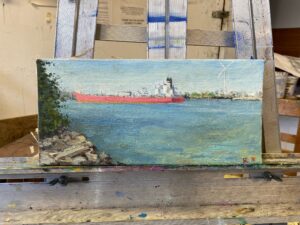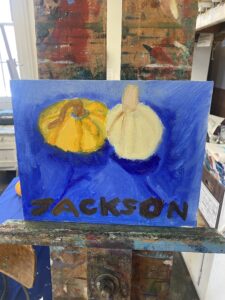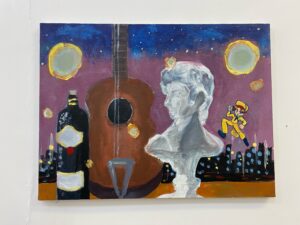Art Lab felt like a blend of different junctures on my art appreciation journey. On one level, it was a regression to a bygone experience of art in my life. My friends and I were in an oil painting class with an instructor, trying our best to mimic the scene in front of us. This recalled my childhood experience of art as the exercise of a skill: developing a technical ability to mimic reality on a canvas. On the other hand, I gained thematic value from observing some of the art pieces which lined the walls, which is how I conceive of art’s value today.
First, I spent my time in an oil painting class. The instructor, an artist herself, explained the process behind her realistic art. She starts abstractly and gradually attempts to replicate real world sights. These include apples and views from Staten Island.


My impression of the overall style of her works is that realism feels antiquated. I gain nothing exceptional from these images of fruit and a boat that a photograph couldn’t have communicated in the same way. That is not to say that a realistic painting has no value. However, a realistic painting does not provide any substantial unique value in terms of the medium itself. Realist art is impressive as far as the mechanics. A person is accomplishing what only a camera can do. However, creativity is limited in the painting process because the artist feels no need to communicate a message. In the same way that abstract expressionists rely on obscurity in lieu of a message, contemporary realist painters rely on their expertise. Their work is based on the notion that they don’t need to do the difficult work of revealing some theme of value because they can stand on their own competency. The vapidness of realism was confirmed by my own experience of actually performing oil painting.
I chose to paint pumpkins.

Initially, I believed that I would try to convey a message. I thought that the variation in the sizes of the pumpkins coupled with their closeness would convey that diverse things can meld well together. This kind of intentionality is artistic. It is the same reason why a photographer is an artist; they choose the subject and how to frame it. However, as soon as I began painting, my higher-order artistic thinking went out the window. All that was on my mind was how to produce the most accurate paint colors, paint the shadows and display all of the pertinent marks of the pumpkins. The artistry ceased once the shot was chosen and thus the resemblance to photography ended. That is because the goal of my realist art was to put my mental image on paper, unclouded by themes or emotions. The entire exercise felt juvenile, hearkening back to a time when the best artist in the class was the person who was most adept at using the medium. I feel like my view of “good art” has matured since that time. It is no longer based on adroitness in wetting the brush just enough to produce aesthetically pleasing strokes. Instead, it is found in the imagination which went into the piece, whether that was the thought behind what subjects to depict or how to depict them. One could argue that when one nails down the technical skills enough, one has the room to add in inventiveness. Professional artists are likely concerned with the message of their work no matter the genre. However, if the art is photorealistic, then there is no original thought beyond the initial framing phase. A painter of realism is best served by being as machine-like as possible.

Due to the emptiness of realism, my favorite part of my finished painting is my name. That part feels personal and infused with authentic thought unlike the remainder of the work.
The art on the walls of the Art Lab reminded me of where I find the substance in art.

First, this painting resonated with me because it has the elements which realism is missing. Through its manipulation of the size of objects, it conveys relative significance. That the sculpture, guitar and bottle of wine tower over the city exhibits that the arts and the bars are what the artist finds beloved in urban life. The relative size also relays the primacy of the individual. Rather than the collective force of the city, the objects which matter to a specific individual are given visual priority. Additionally, the purple colored sky conveys tranquility. The artist is communicating that they find immense solace in the highlighted aspects of their life.

Second, where I can appreciate realism is in the above painting, which also graced the Art Lab walls. The artistic value is found in the setting choice. In fact, this image would make for a photograph which is just as beautiful. The painting depicts an object of possession in a way Berger would have despised, but I find it quite charming. The image embodies the success of retirement. The caption ought to be: a person sighs with satisfaction and takes one last look from the dock at their boat after a long day of wading through the sea. What is picturesque is not even so much the sunset, but that the sunset feels like it is a merited reward. The spectator is placed in the shoes of a person who has earned the luxuries of island life after years of material acquisition. The sun is setting on one’s life and yet, this painting captures that one still has many moments left to relish in one’s own greatness. I don’t look forward to aging, but this painting makes me question whether I should. One dreams of coming to a point in life where one can just bask in all their accomplishments. There is nothing which says wallowing in one’s own success like buying a boat, which fulfills no practical need other than that very human impulse for delighting in one’s own preeminence.


